A few years ago the idea that mainstream european automakers would be focusing so much effort on minuscule electric urban runabouts would have been met with derision.
But a few weeks after it unveiled its third generation two-seat urban concept vehicle at the 2011 Frankfurt Auto Show, Renault has announced the pricing, specification and ordering details for customers in Europe.
But will cars like Renault Twizy, Audi Electric Urban Concept, Volkswagen Nils or Opel RAK e ever become popular? Will they ever make it to the U.S, or are they just too small and quirky to be taken seriously?
Certainly cheap
The Twizy isn’t the first two-seat electric urban runabout to make it to market, but it is the first of its kind from a mainstream automaker.
At a starting price of £6690 ($10,350) with a monthly battery rental of £40 ($61) per month, the 2012 Renault Twizy is certainly the cheapest electric car from a mainstream automaker on the market. And unlike other electric vehicles of similar price -- such as two or four-seat limited-speed neighborhood electric vehicles like the G-Wiz or GEM range of glorified golf carts -- it does get a driver’s airbag and up to 60 miles of urban range.
But not as safe as a car
Just like those aforementioned vehicles though, the Renault Twizy is classed as a neighborhood electric vehicle, meaning it isn’t required to pass the same tough crash-test safety standards that a conventional electric car has to.
While it may look cute, it hasn’t had to prove itself in a suite of tough National Highway Traffic Safety Administration (NHTSA) crash tests
As the U.K. learned last year, a crash between a neighborhood electric vehicle and a conventional car the can be really horrific..
Restrictions make it pointless
Its classification makes the 2012 Renault Twizy and rebadged Nissan equivalent currently being tested in Japan completely unsuitable for U.S. consumers due to tough laws here.
Being a neighborhood electric vehicle, most states would require it to be limited to a maximum speed limit of between 25 and 35 miles-per hour, only allowing it to be driven on roads with a posted speed limit of 45 miles-per-hour or less.
That makes the Twizy another NEV -- albeit one made by a mainstream automaker.
Too limited
Until automakers can build tiny urban electric cars with the crash-test capabilities of much larger cars with the speed and performance to match, these tiny european urban runabouts are unlikely to get sold in the U.S.
Admittedly, some of the other electric concepts we’ve seen from Audi, VW and Opel are much more car-like than the Twizy -- and have higher top speeds and more safety features.
But even if it were ready to tackle an NHTSA test, the Renault Twizy and cars like it would still be tough to sell to most U.S. consumers. In a country with big cars
Given the same privileges as motorcycles , perhaps more would be interested to use cars like the Twizy as a commuting vehicle, but until then we can’t ever see these quirky cars making it to the U.S.
What about you?
Are these tiny little urban concepts the future of electric mobility, or are they death-traps that damage the reputation of electric cars and need to be kept off the road?
Let us know your thoughts in the Comments below.
+++++++++++



















